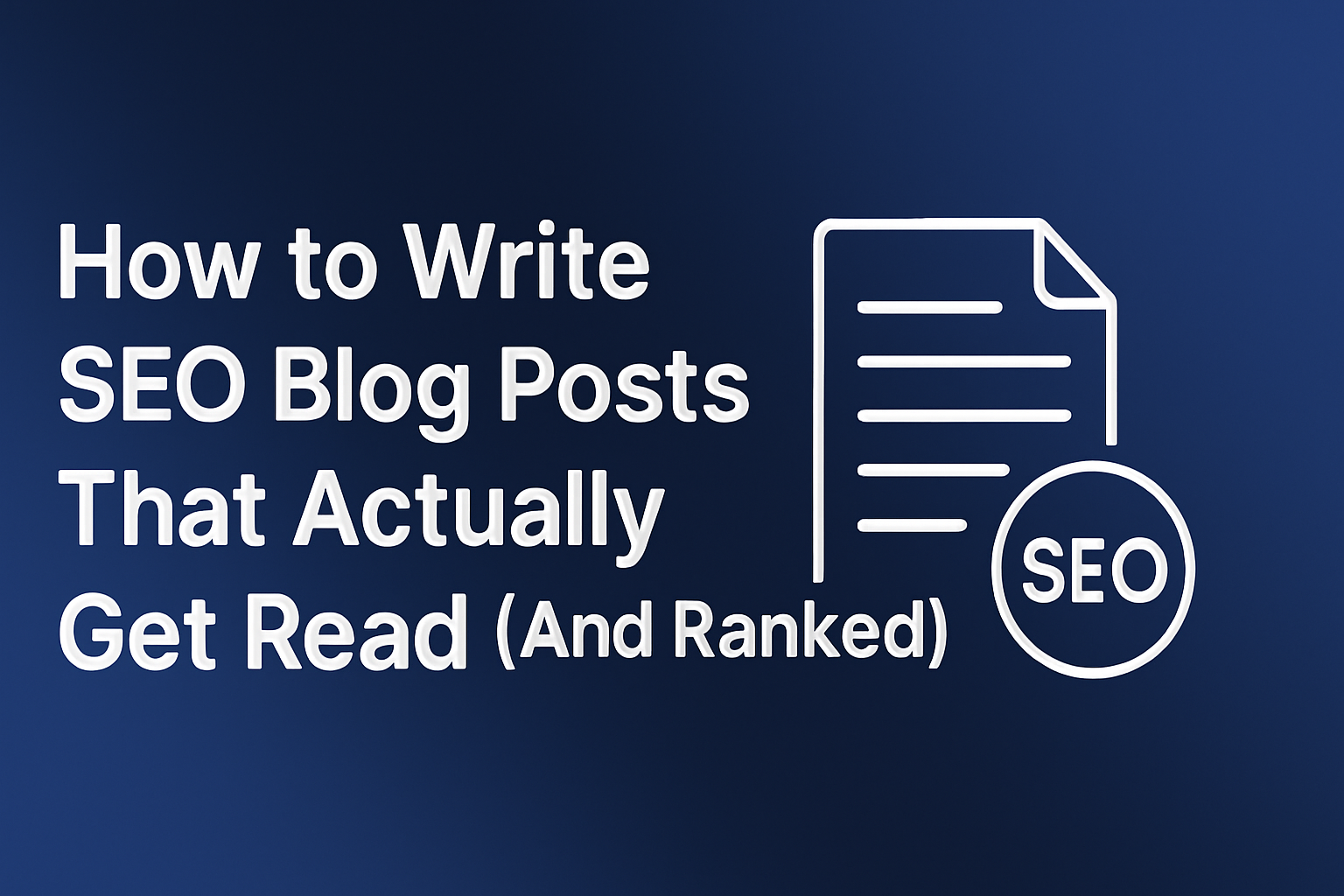How to Write SEO Blog Posts That Actually Get Read & Ranked
91% of Blog Posts Get Zero Traffic. Yours Doesn’t Have to.
91% of blogs get no traffic from Google. That’s almost all content online, floating in the dark, unseen and unread. Here’s the hard truth: Google doesn’t care how long you worked on your post. If it doesn’t match search intent, doesn’t hold attention, or isn’t optimized—it’s invisible.
Most creators skip the basics. No strategy. No keyword research. No structure. They write and pray. And then feel stuck. But there’s a better way.
This guide breaks it all down. You’ll learn how to choose the right keywords, write in a way readers love, and format posts that rank on Google.
It’s simple when you follow the steps.
No tricks. Just smart writing that works for both humans and search engines. If you want your content to be found, read, and shared—this is your starting line.
Why Most Blog Posts Get Ignored
You write a post. It’s helpful. It’s detailed. You hit publish. And then? Nothing. The biggest reason blog posts fail isn’t the writing—it’s the planning. Most writers jump straight in without a strategy. They guess keywords. They write for themselves, not the reader.
They ignore formatting, structure, and intent. SEO isn’t an afterthought. It’s the foundation. If your blog doesn’t answer a real question in the way people expect, Google pushes it down. People bounce. And your post dies in silence.
Want traffic? Start with what people actually search for. Build around that. Every word you write should solve one specific problem. This isn’t just about writing. It’s about writing for results. That’s how you turn content into clicks—and clicks into trust.
Why Google Ranks Some Posts and Buries Others
Google’s one job is to give users the best answer—fast. So, when someone types a question, Google wants to send them to the page that ends their search.
That’s it. If your blog doesn’t satisfy the searcher, it gets buried. But when someone clicks, stays, and reads the whole thing? Google rewards you. The secret is relevance. You don’t need fancy tricks. You need a clear solution, strong structure, and great UX. Long content won’t help if it’s off-topic.
Fancy words won’t help if they confuse the reader. Write clearly. Match intent. Keep people scrolling. That’s the game. Your blog needs to feel like the final stop.
The place where questions end. When your post becomes that—it ranks.
What SEO Writing Really Means in 2025
SEO writing is more than keywords. It’s content that works—for people and search engines. That means clear structure, strong signals, and real value. It starts with a solid title. One that includes your keyword and hooks the reader.
Then comes the intro. Speak to the problem they feel. Then deliver answers fast. Use H2s and H3s to break it up. Make it easy to skim. Short paragraphs. Clear sentences. No fluff. Keywords still matter—but only when they’re used naturally.
SEO writing today is about experience. Does your post help someone? Does it keep them on the page? Do they click deeper?
All these send signals to Google. So don’t just write. Write like you’re solving one real problem. That’s what ranks.
Step 1: Do Keyword Research That Feeds the Strategy
Start with your reader. What are they Googling? Go to Google itself. Type your topic. Look at “People Also Ask” and autocomplete suggestions. Tools like Ubersuggest or AnswerThePublic help too. Pick long-tail keywords with lower competition.
These are easier to rank for—and more specific. Example: Instead of “marketing,” target “email marketing tips for beginners.” Find 2–3 keywords per post. One main. Two supporting. Add these into your title, subheads, intro, and conclusion. But don’t overdo it.
SEO today rewards natural writing. This step sets the direction. It’s the difference between wandering in the dark and following a map. Without it, your blog’s just noise.
Step 2: Match Search Intent or Fail Fast
Let’s say someone searches “best podcast mics under $100.” What do they want? A list. With options. Maybe reviews. Now imagine you write a guide about how podcast mics work. Helpful, sure—but not what they asked. They’ll bounce. You lose. Every keyword hides intent.
It could be informational (“how to start a podcast”), transactional (“buy podcast mic”), or navigational (“Blue Yeti review”).
To rank, your post must match that intent exactly. Before you write, Google your keyword. Study the top 3 results. Match the format—but go deeper. Add clarity. Add value. Give the reader what they expect—and then some. When you match intent, you earn trust. And rankings follow.
Step 3: Create a Strong Outline First
Outlines sound boring. But they’re the secret to writing fast, focused content. Without one, you ramble. You lose the reader. Google gets confused. Start with your H1—your title. It should include the main keyword.
Then build your H2s: these are your core sections. Each one should answer a common question or solve a key pain. Use H3s to expand, explain, or break down lists. Think of your outline as a table of contents. If a reader skims it, they should know exactly what they’ll get.
Use real queries from search engines to shape each subhead. Don’t freestyle. Map it out. That’s how you write content that ranks, reads well, and converts.
Step 4: Write Like You’re Talking to One Person
Imagine you’re helping a friend. That’s how your blog should feel. Use “you.” Keep paragraphs short—3 lines max. Use plain words. Don’t try to sound smart. Just be helpful. Start strong. Explain the problem fast. Then go step-by-step through the solution.
Use bullet points. Add subheadings. Break it up. People scan, not read. Writing for people means clarity. Writing for search means structure. Do both. Mention your keyword early, in the first 100 words. Use it in at least one H2. But don’t stuff it.
Google’s smart enough now to catch that. Be real. Be clear. Be useful. That’s how you win readers—and rankings.
Step 5: Optimize the Tech Behind Your Post
Behind every top-ranking blog is a clean setup. Here’s what to check before you hit publish:
- Keep URLs short. Include your main keyword.
- Add a meta title and description that promise a clear benefit.
- Compress images to load fast. Under 100 KB if possible.
- Use descriptive file names and alt text.
- Make sure the site is mobile-friendly and loads under 3 seconds.
- Add internal links to 2–3 related posts.
- Submit the post URL to Google Search Console.
These steps aren’t flashy. But they matter. They help Google crawl, index, and trust your content. And they keep users happy while reading it. When tech works with content, magic happens.
Step 6: Interlink with Intention
Internal links keep readers on your site longer. They also tell Google what your site is about. Before you publish, pick 2–4 posts to link from.
Use natural anchor text—like “see our blog post checklist” instead of “click here.” Then go to older posts and link them to your new blog. This gives your fresh content a traffic boost and builds topic authority. The result? Higher rankings over time. Interlinking also improves user experience. It guides readers to what they need next.
Don’t treat your blog posts like islands. Connect them. That’s how you build a content ecosystem that Google loves.
Step 7: Promote It Like a Product
Clicking “publish” doesn’t mean you’re done. Now comes the part most skip: promotion. Share your post in your email newsletter.
Turn it into a LinkedIn post. Tweet the headline and link. Post key takeaways on Reddit or niche forums. Turn tips into Instagram slides.
Tag tools or people you mention. Ask them to share. The more visibility you get early, the better your chance of ranking. Google watches engagement signals. If people click, comment, and stay—your blog moves up.
Don’t rely on SEO alone. Amplify your reach. Promote with purpose.
Step 8: Use Backlinks to Push It Higher
Backlinks tell Google, “This post matters.” But you don’t need 100. Just a few from the right places. Start with HARO (Help A Reporter Out). Answer journalist queries. Link back.
Reach out to other blogs. Offer to write a guest post. Or build something worth linking to, like a tool, template, or stat roundup.
Each quality backlink boosts trust and rankings. If you get even one link from a high-authority site, it can push your blog from page 3 to page 1. That’s the difference backlinks make. Slow and steady wins here. Stay consistent.
Most Posts Fail. Yours Won’t.
Now you know why most blog posts vanish—and how yours won’t. You’ve got a step-by-step roadmap: research the right keywords, match the intent, outline clearly, write for humans, optimize the tech, link with strategy, promote smart, and build trust with backlinks. Simple steps, repeated with care.
That’s how blog traffic grows. Don’t wait.
Pick a keyword today. Map your outline. Write your first draft. Follow this process and you’ll see what happens when your post stops hiding. It ranks. It connects. And it brings your readers exactly what they were searching for. Keep writing—but write to be found.







